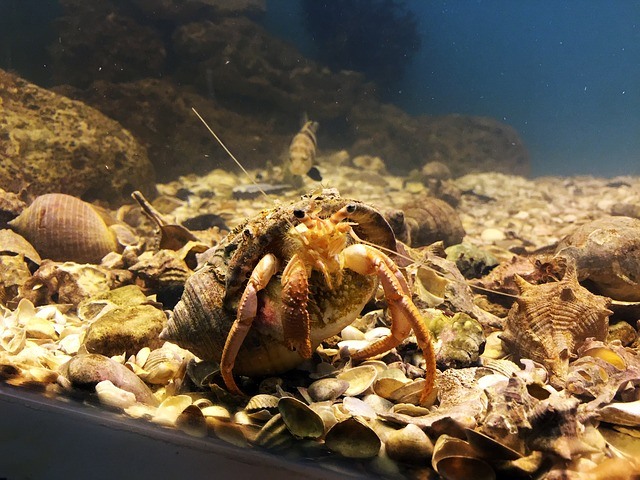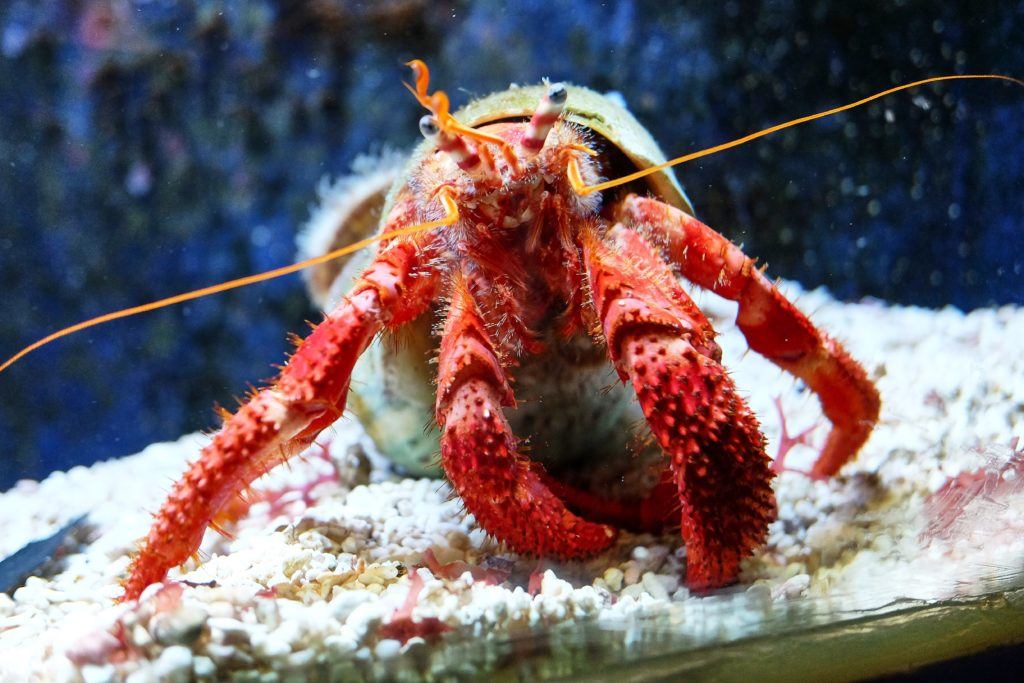Hermit crabs can be a great little pet for those with limited space, but what are these little creatures?
The kind you find in pet stores are land hermit crabs, and are native to tropical areas of the Indo-Pacific, western Atlantic, and western Caribbean.
Although they are land-dwellers, they live close to water in the wild. They actually have modified gills that allow them to breathe outside of the water, but they need very humid air in order to breathe properly.
Under good care, they can grow up to six inches long, and live up to ten years!
Despite their name, hermit crabs are social crustaceans and live together in pairs or small groups. As they grow, they molt and change their shells for larger ones.
They have some unique needs, so how do you set up a hermit crab aquarium to keep them happy and healthy? We’ll show you how!
Contents
The Perfect Hermit Crab Habitat
Where do you begin when creating a hermit crab cage suitable for your new pets? The most important thing is to set up the enclosure before you add the crabs.
When you purchase your crabs, they will likely be stressed from transport, and if introduced to an environment that isn’t already stable in temperature and humidity, they could become ill – or even die.
The Hermit Crab Tank
A good hermit crab enclosure should be at least ten gallons and made of glass. A ten-gallon tank is good for two small-to-medium-sized crabs, but if you want more or larger crabs, a larger tank is required.
You should not use a wire mesh cage, as it doesn’t hold the necessary humidity well for the crab’s unique gills.
You’ll see hermit crabs displayed in these types of cages usually by a beach, where the air is naturally very humid, but in your own home, it’s harder to maintain.
Hermit crabs are very strong climbers, and can even climb the glue at the seams of a glass tank, so make sure you have a secure lid! If your house is humid and warm enough, you can use a wire top, but a glass or plexiglass lid is recommended.
If you decide to use a wire mesh lid, you can cover most of it with plastic wrap to help contain the humidity as well.
Before you set up anything else, clean the tank with a biodegradable cleaner, then rinse and dry completely.
Make sure when you set up your tank, it is in an area that is not in direct sunlight, near vents or drafts, or anywhere that could be exposed to extreme heat or cold.
It’s also suggested not to put it in a high traffic area so that you don’t stress out your crabs.
Heat and Humidity
So how do you make the tank humid? Well, you’ll need heat, a water source, and a way to measure all of it.
First, you’ll need two thermometers and a hygrometer to measure the levels within your tank. Place one thermometer on either end of your tank so that you can create a “cool” end and a “warm” end for your crabs.
The ideal crab temperature should be 75-85 degrees, with a humidity between 50-60%. If your hygrometer measures relative humidity and not actual humidity, the levels should be 75-90%.
Too high a temperature can hurt your crabs, and too low will change their metabolism and make them more prone to disease and lethargy.
There are a few different ways to heat your tank. An under-tank heater is the best way to provide heat without drying out the air.
You can also buy a hermit crab heat lamp or a 15-watt reptile heat lamp that goes above the tank, but make sure you do not choose anything with too high a wattage.
It is safe to use fluorescent bulbs that provide UVB and UVA light, incandescent bulbs, night-time heating lamps, or a combination of these with your crabs. Whatever you use, make sure you put it on a timer to keep your crabs in a regular day/night cycle.
Now that you have heat, it’s time to add the moisture. Place a large water bowl in the tank. This bowl should have a low enough lip to allow your crabs simple entry and exit, but deep enough that they can submerge in it.
Be sure you are always using spring water, or chlorine-free water, otherwise you run the risk of sick crabs. You can also periodically mist your tank with the same type of water.
If you are still not getting the right humidity readings, you can make a bubble bowl using an airstone, like the kind typically used for fish aquariums.
Place the airstone in your bowl of water, and use the tubing to connect it to the pump. The water will bubble from the airstone, not only releasing more moisture into the air but also keeping the water fresh for your crabs.
Hermit crabs will also need a source of saltwater. Get a second bowl that they can also submerge in, and make sure it is deep enough for your largest crab.
It is recommended that you put this in a low area of the habitat to mimic a natural shoreline. To create your salt water, you can either buy pre-mixed saltwater from the pet store or make your own from scratch.
Do not use table salt! Using spring or chlorine-free water, mix 1 ½ tsp. of sea salt with one cup of water.
Substrate
For the substrate, you have a few different options. It should be sand, a sand mix, or earth.
You can use coconut fiber, crushed coral, play sand, reptile sand, Aragonite sand, or any other substrate made specifically for hermit crabs.
Make sure you never use cedar or other conifer substrates, peat moss, gravel, wood chips, or any other substrate that will not allow your crabs to dig.
Sponges are also not recommended, as they can encourage the growth of bacteria that will make your crabs sick. Find a substrate that will be easy for you to clean.
Whatever you choose, make sure it is at least three times deeper than your largest crab. This depth will allow them to burrow and gives them a safe place to go when they are about to molt.
Arrange your substrate so that there is a low and a high end of your tank. At the low end, place your saltwater bowl. This will help mimic the natural environment.
Keep the low end of the tank extra moist by misting the substrate, or place a container of terrarium moss there.
Decor
Now that you have your substrate, your water bowls, and your heat supply, it’s time to make your crab habitat cozy and fun.
Place a few different heavy food bowls in the tank. Multiple food bowls ensure that each of your crabs are able to eat without competition, and the bowls should be heavy enough that they can’t get knocked over and spilled.
Hermit crabs like to climb, and you can decorate accordingly. Branches, driftwood, caves, coral, fake plants and vines, ceramic pots, and wooden or plastic shelters are all good options.
Make sure to avoid metal and anything that is painted. If the paint starts to flake, the hermit crabs may try to eat it and make themselves sick. You’ll also want to ensure the tank has extra shells for your hermit crab to move into.
Have at least three extra empty shells per crab. These should be the same size or slightly larger than your crab’s current shell, and like the décor, should not be painted.
Hermit Crab Care
Now that you have your tank set up, the humidity and temperature stable, and the substrate and decorations laid out, it’s time to add your crabs!
Food
Hermit crabs are natural scavengers, and their diet needs to be diverse to keep them healthy. While there is commercial crab food available, it is best to feed them a combination of fresh food and commercial food.
Offer them frequent servings of seaweeds and algae, proteins, and fresh fruits and vegetables. They can also chew on some of your decorations, including cork bark, grape wood, cholla wood, and natural hemp.
Fresh foods safe to feed them include: organic earthworm castings; mealworms; shrimp; organic popcorn; chopped fruit, chopped, dark, leafy greens; carrots; and more.
It is best to use organic foods when possible, as they are sensitive to pesticides. Crabs are also very sensitive to metal, so make sure their food and water bowls are ceramic.
Hermit crabs take very small bites and feed primarily at night, so don’t be surprised if it takes them a while to finish a meal.
Cleaning
Because of the high humidity required to keep your crabs healthy, you’ll need to clean the tank about once a week.
Wash, rinse, and completely dry the food and water bowls, and check the substrate for any pieces of leftover food.
Once every four to six months (or sooner if you start to see mold, mildew, or gnats), change the substrate completely.
Remove all of the decorations and bowls, wash the enclosure with vinegar and rinse thoroughly, and boil all decorations and empty shells before putting your tank back together.
Signs of Disease
Hermit crabs are relatively hardy, but there are a few sure signs that something is wrong.
It may be time to consult an expert or a veterinarian if you start to notice anything unusual such as: decreased appetite or activity, staying outside of their shell, excessive molting, loss of claws or limbs, or a strong odor from inside the shell.
Here’s a video showing more details on hermit crab care and habitat.
What are some of your hermit crab habitat ideas?






